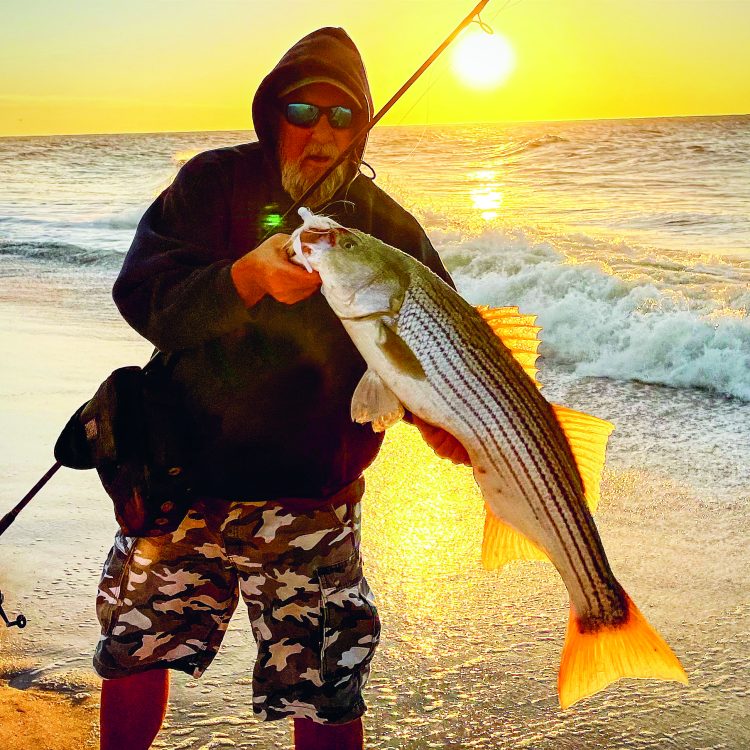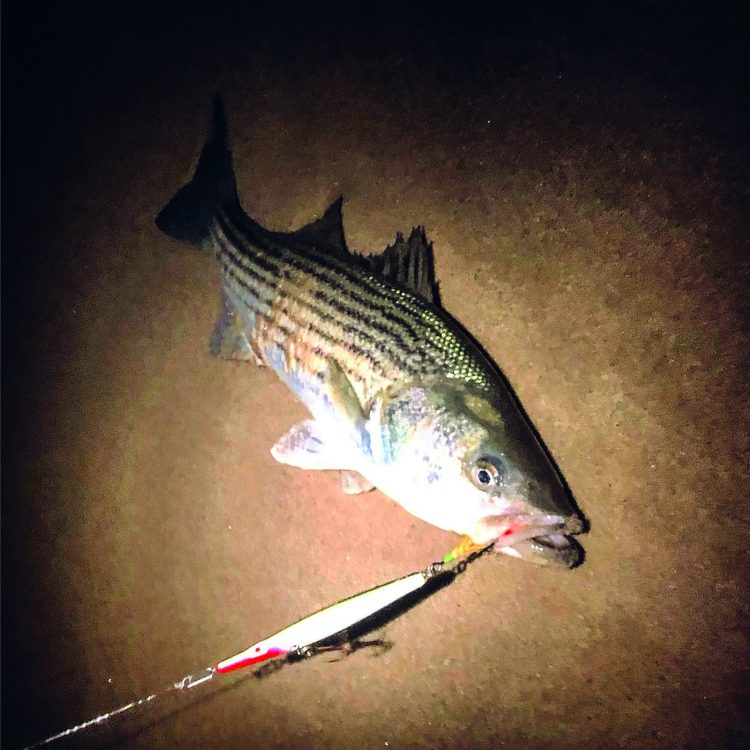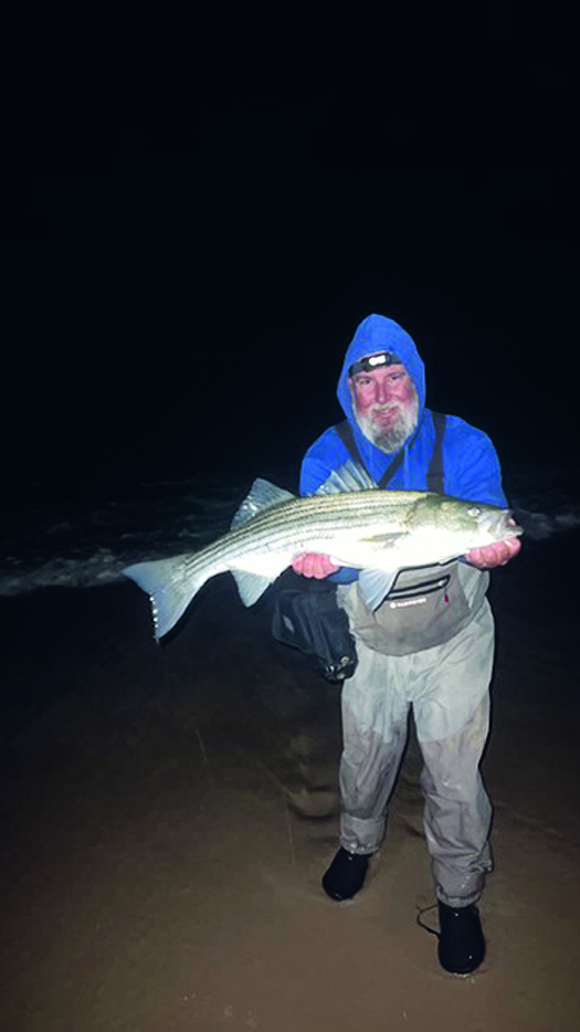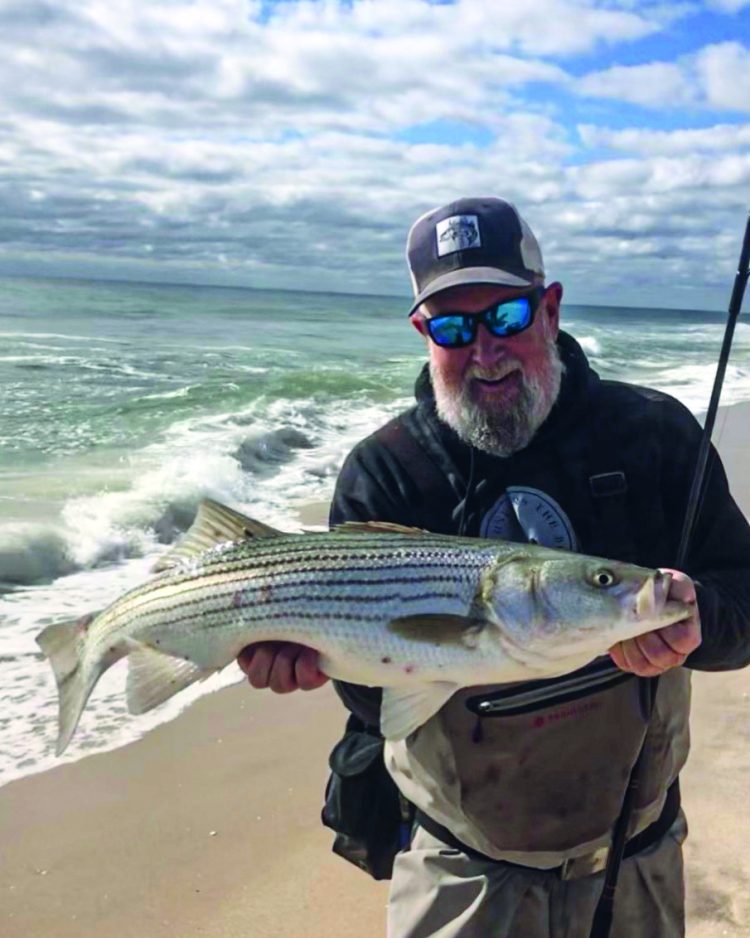Home Field Advantage in the Surf
Resist the temptation to chase distant reports, and dial in your local waters.

My coffee had cooled down just enough to take a sip without melting the roof of my mouth. It was time to pull out of the 7-11 and get that big fish I’ve been waiting on. Should I head north to the highway for a longer drive west or head south for a short drive to a handful of familiar spots that had some fish at sunset? I’d been seeing posts and hearing reports of nice fish around Jones Inlet and a few other unfamiliar places. They were areas where I didn’t have a feel for tides, structure, or the essentials necessary to have a shot at some solid fish. Based on what the odds were of making that long drive and having a great session, I might as well go back into the store and buy some scratch-offs.
Late into the fall run, being indecisive tortures me. Being willing to leave local knowledge behind and chase a report is tempting and one of the most powerful tools any angler has, but it is rarely the right move.
My growing confidence in a bucktail, more scouting of local beaches, and an intel network with local surfcasters had been paying higher and higher dividends every year. However, there were bigger fish I could catch, and to catch them, I had to push out of my comfort zone. It called for more hours at night and throwing more than just bucktails and paddletails. There were darters, needlefish, and metal lips hanging on the walls of my garage and in Plano boxes that had made their way from local tackle shops and fishing shows to the wall because of the stories I’d heard and videos I had seen of the big fish they caught. I’d thrown them a few times but never caught on them or felt what their true action should be.

My local tackle shop mentor cut through my frustration a couple of seasons back. He commended me on the confidence I had built up for bucktails and told me to fish a needlefish the same way. The light bulb went on, and a few nights later, I caught fish after rotating through different weights. It took some time to find the sweet spot of how many ounces stayed in the strike zone the longest. I gained one more tool in my arsenal and a few open spots on the garage wall as needlefish became regulars in my bag.

A season later, as the chill of November nights set in, I caught a few fish on a darter. They were mostly shorts, and I was fishing some fast-moving water on the bay side of a local inlet. I was hoping for bigger fish, but the goal was to get a feel for working a darter. That strong current was a perfect introduction. Seeing the end of my retrieve in gin-clear water close to the full moon gave me all the proof I needed to know I could work one in the surf.
In past seasons, I had attempted to fish a darter off the beach here and there. On each attempt, I didn’t make more than a dozen casts before putting it back in my bag. It wasn’t a popper I could see splashing across the surface, and it wasn’t an SP Minnow or bottle plug that sent vibrations through the line, but I knew, from more experienced surfcasters, that they caught fish.

It was a warm night for late November, and the new moon was a couple days away. The fishing hadn’t been great, but there were enough to convince everyone we hadn’t seen the last of that year’s stripers. The first cut I drove past had a dozen guys fishing and multiple fish flipping in the wet sand at their feet. Etiquette kept me driving to some productive, less-crowded structure on the beachfront adjacent to the inlet rocks. There was a bit of a crowd, but a nice stretch of structure with plenty of room. I spotted a buddy’s truck and sent him a text. A moment later, I was walking towards his blinking red headlight.
In the previous hour, he had gotten multiple good fish on a darter. This was the same buddy who kept pushing me to put this deadly plug into my growing arsenal. I knew the structure and contour of what I was casting into, but underestimated how late into the outgoing tide it was. After only a few cranks into my first retrieve with the darter, I was dragging on the inner bar before dropping into the trough. After that first cast, my buddy heard the ripping of Velcro on my bag and saw my headlight go on.
“Don’t do it, bro.”
I felt like a 5-year-old who got busted when he was too loud with the lid of the cookie jar. As I clipped on a needle that would cast further past the bar, I felt confident that the experience I’d gained to date with it would produce. I went from a newbie state of mind to knowing I had a shot at hooking up. I didn’t, though, and my buddy working his darter in the troughs did for the next half hour.
What I missed in making the decision to switch was the cut about 75 yards east of us that allowed bass to move in close and attack the baits stranded in the troughs as the tide went out. I missed that crucial part not because I forgot, but because I wasn’t fully committed to fishing a new-to-me plug.
The darter went back on, though it was more difficult to work it through the troughs than in the fast-moving water where I’d become acquainted with the lure. A half-dozen fish came up to my left and right as I kept at it with more faith than trust, but then I got a bump. I got a bite a few casts later but still didn’t connect. Even so, I was on the doorstep of my first fish on a darter. My buddy reminded me that unlike bucktails, paddletails, and needles, a bass doesn’t always get a clean shot at a darter, so a swift hookset is crucial.
I kept casting and working the plug, though tide and time weren’t helping. Soon enough, there just wouldn’t be enough water and the fish would move out. Since I wasn’t able to control either of those factors, I kept my retrieve cadence the same as when those bumps and bites put me into a silent frenzy in my head.
Suddenly, the little bit of resistance my slow retrieve was working with became a lot of resistance and an instant bending of my rod tip. A solid hookset, the immediate thumping of my rod, and I was dancing with my first fish caught on a darter. It wasn’t a schoolie—nor was it a cow—but it was enough of a fish to acknowledge a win. One more tool for the arsenal, and one more bit of knowledge for fishing that spot.
I had only a few weeks of the season left to employ my new tools and confidence, and there weren’t as many fish around. Coming up blank working darters and needles had me wanting to go back to bucktails and paddletails … fear and doubt, two of the absolute worst things to bounce around in a surfcaster’s head. That fear of not catching another bass before the final rinse of my gear felt big and real, but so did the doubt. I was able to dismiss it for the most part when I replayed the fraction of a second when I felt the first bump on a darter. With a gut check of sorts, I kept throwing the darter, the needle, and slow-rolled metal lips. I’d rather finish the season by going out swinging and not abandoning the work I’d put in to catch one more fish on a bucktail. When I aired back up for the last time, there wasn’t a personal best down the homestretch of that fall run. I left it all on the sand, and with new lessons to learn next season, I’d have a lot more to tackle the fish with.

Living 100 miles or so northeast of the first reports of spring striper catches in New Jersey can be triggering, not just to ready the gear I procrastinated about tuning up during the lazy winter months, but the expectations and excitement to get back into the grind. There’s no debating whether to stay local or make the drive in the spring. The fish are there and not here. The only debate is the willingness to roll the dice on an early season trip.
I made the trip and caught fish, and all was right and good in the world again. Any offseason rust was shed quickly as my Jersey friend and I waded into one of his local haunts. Bucktails and paddletails were the profile and action matches for the emerging residents and early migrators. I was dialed in for a couple of weeks. The fish were bigger if I made a much closer drive west than to New Jersey as the fish headed to the bays and inlets close to home. I wanted (and practically expected) a 30-pound or bigger fish after my first darter catch. I wanted a big one and wanted it now.
I was back in that 7-11 lot waiting for my coffee to cool on a crisp spring night. Unlike a crisp fall night, it was instant gratification and not the fear of missing the last fish. On any given cast in the places I knew and had been fishing for close to a month, the first big migrator might be caught. I could up those odds by hitting a number of spots where it could happen with my knowledge of how to fish them. A scroll through social media was enticing, but not enough. That spring night and following ones, I stayed local and I caught fish. They were teachable-moment catches and not necessarily epic ones. My knowledge grew, my confidence grew, and how I fished new plugs in the rotation improved.
In the blink of an eye, the spring bite was over and the summer doldrums were here. When those first cooler nights of late August and early September arrived, so did that enthusiasm and excitement for a fall run, knowing more than I did the year before. It was a great one. The choice to stay local or chase reports to the west of me wasn’t as torturous until the fish really had left town. It was then okay to put on the right blinker and head to the highway.
Related Content
7 Striper Lures for Sand Beaches
Leave a Reply